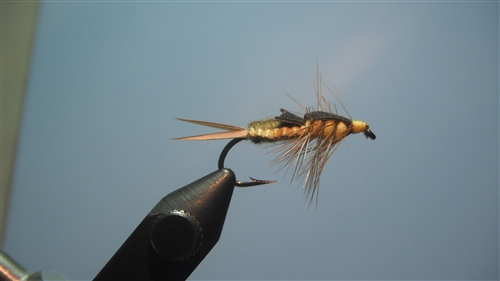Here is the pattern I tie.
WOVEN PERLA STONEFLY NYMPH
MATERIALS
1. Size 8 - 12 nymph hook
2. Thread yellow
3. Underbody – Heavy lead wire
4. Antennae – Tan Goose biots
5. Tail – Tan Goose biots
6. Abdomen – Floss DMC 727 yellow and 898 or 433 Brown
7. Wing case – V-clipped turkey tail quill or mottled thin skin wing case materiel
8. Thorax – Mixture of Hareline dubbing yellow #8 and #9
9. Legs – Brown saddle hackle palmered through thorax.
INSTRUCTIONS
1. Crimp the barb and place the hook in the vice.
2. Attach the thread along the entire hook shank.
3. Attach lead wire at the front of the hook and wrap the lead in tight spirals ¾ the length of the hook shank. Make sure you leave room at the eye.
4. Wrap thread back and forth along the lead wrapping. Leave the thread at the rear of the hook. When complete, use a pair of needle nose pliers to flatten the lead. This will give the fly the appropriate flat body shape. Another option is to tie in a lead strand on each side of the hook. In this method, you will not need to flatten the lead. In either style, use the thread to make a nice taper at the end of the lead to the rear of the hook.
5. Attach two goose biots, split for the tail.
6. Cut a 6” piece of each the yellow and brown floss. The floss has 6 strands. Separate the floss into a 3 strands. Tie one yellow section of 3 stranded floss to one side of the hook and one brown section of 3 stranded floss to the opposite side of the hook, beginning at the thorax level to the bend of the hook.
7. Weave the floss as follows: Always keep the brown floss on top of the hook and the yellow floss on the bottom of the hook.
• Make a horizontal loop with the brown floss on the side it was attached and extend the tag end over the top of the hook. The tag end will extend over the hook shank and (on top) over the attached yellow floss.
• Take the yellow floss over the tag end of the brown floss and underneath the hook shank, and up through the horizontal loop formed with the brown floss.
• Pull tight with even pressure on both sections of floss. The first weave is complete. The floss colors are now on opposite sides of the hook shank.
• Repeat the exact same process in the opposite direction. ALWAYS keep the brown floss on top and the yellow on the bottom.
• Continue the process until the lead is covered and tie off the floss.
8. Tie in the wing case material at the thorax site. This fly has two wing cases. The wing case is tied in with a tag end towards the hook bend and a tag end towards the eye of the hook. Trim a “V” shape into the rear section of the wing case.
9. Tie in a brown hackle feather to match the size of the hook.
10. Dub the thorax.
11. Attach two goose biots, split for the antennae, on top of the hook and tie off.
12. Wrap the hackle feather forward through the thorax and tie off.
13. Pull the wing case over the hackle and tie off.
14. If thin skin is used as a wing case material, color with a brown sharpie marker to produce a gloss wing case. If you have not address the shape of the rear wing case, trim a “V” shape into this section of the wing case.
Flytying\Woven Perla Stonefly Nymph






